Hunger Pains: Food For Thought
The story was co-published with The Sacramento Observer as part of the 2024 Ethnic Media Collaborative, Healing California.
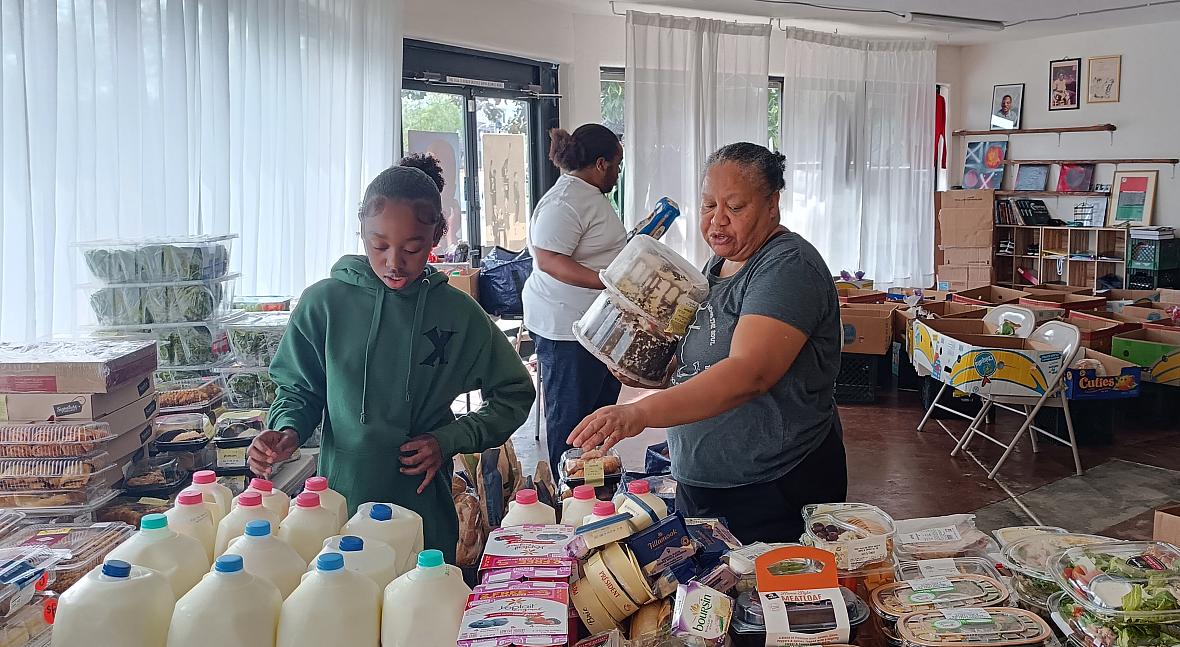
The Neighbor Program is empowering people to help fill in the food gaps in Oak Park. A Malcolm X Academy student Shanice, 10, helps fellow volunteer Sabrina Hudson fill food boxes that will go to area residents.
Genoa Barrow, OBSERVER
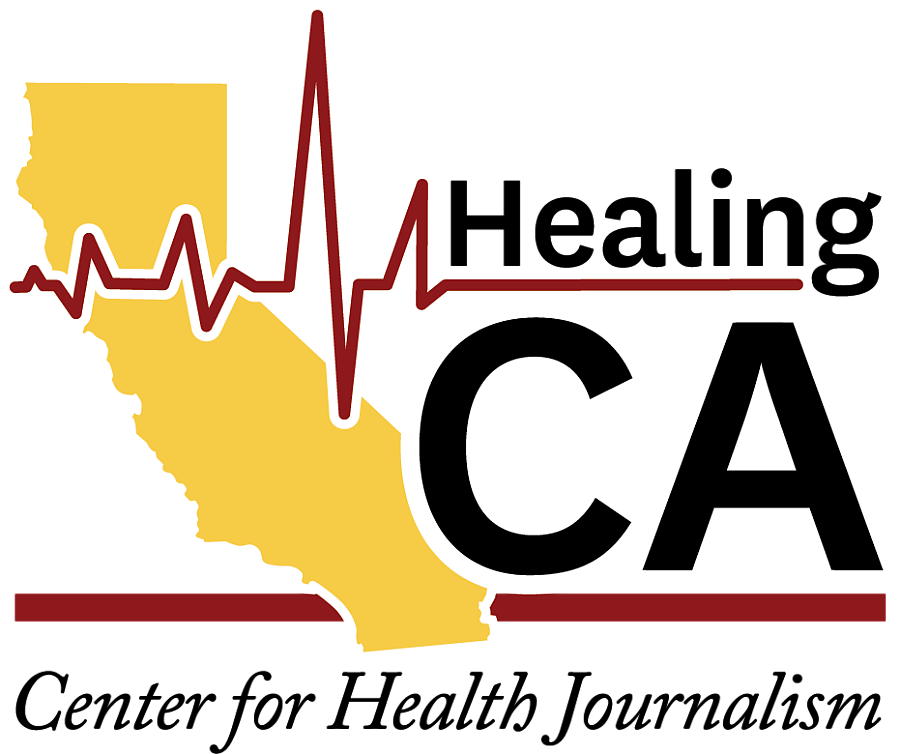
Greater numbers of people are looking beyond traditional sources for their monthly grocery needs, as inflation pushes up food costs to unaffordable levels and the lack of healthy food in many communities makes day-to-day life challenging.
Mixing systemic racism, low wages, unemployment and resulting poverty is a troubling recipe for long-term, and in many cases generational, food insecurity.
Racial disparities in food security predate COVID-19, but the pandemic heightened matters. Feeding America estimated that 1 in 5 African Americans experienced food insecurity in 2022, at a rate of almost two-and-a-half times that of whites.
Blacks are also more likely to live in food deserts, areas with little to no access to healthy and affordable food options. Living in a food desert often means traveling far to shop, or for those who can’t, shopping at convenience stores and mini marts like 7-Eleven and AM/PM. Many of these corner stores are more likely to sell liquor and junk food than healthy food options.
Armed with the knowledge that food insecurity can lead to poor outcomes and impact the community’s overall health and well-being, Black organizations have taken the lead in addressing the multi-layered issue.
The “for us, by us” concept isn’t a new one.
Advocates and activists are reaching back and tapping into a long history of self-sufficiency. The Black Panther Party for Self Defense (BPP) stood in the gaps for the community during tumultuous times marked by racial discrimination and inequality.
The BPP was founded in West Oakland in 1966 by community college students Huey P. Newton and Bobby Seale. Their message of Black self-sufficiency got them labeled as dangerous and targeted by the U.S. government. The group’s free breakfast program became one of its most successful social programs, feeding thousands of school children across the country. Members understood that in order for children to learn and grow, they had to be properly nourished.
“Ensuring access to nutritious food for Black communities was as central to the Party’s mission as putting a stop to police brutality,” wrote food writer Elazar Sontag in an introduction to a 2020 “Eater” article by Sacramento-based Panther historian Billy X Jennings.
“If you do not have food — and the correct types of food — you’re not going to last too long,” Jennings wrote. “It’s going to affect your health. It’s going to affect how long you’re going to live. It’s going to affect your kids’ health. We were dealing with people’s survival.”
The Bay Area free breakfast program model spread as BPP chapters sprang up across the country.
Even as the government vilified the Panthers through the FBI, the Department of Agriculture (USDA) recognized their reach and used their example to expand its federal school breakfast program.
The Panthers also ran a widespread free grocery program that helped struggling families in communities plagued by low wages, unemployment and high incarceration rates. The BPP’s legacy of feeding the people and rallying legions of volunteers offers a blueprint for modern-day advocates and activists to help ensure the health and well-being of the community.
‘Free’ Food
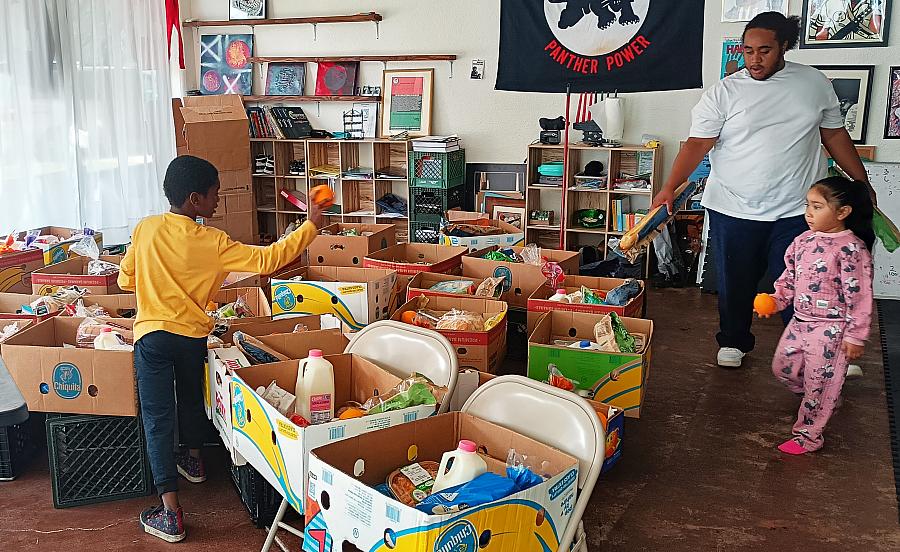
Weekly prep for food distribution at The Shakur Center provides an opportunity for the next generation to learn the importance of serving the community. Malcolm X Academy students like Jayden, 6, left, also learn math and food science while addressing food insecurity.
Genoa Barrow, OBSERVER
“Freedom from hunger” takes on additional meaning for organizers of Sacramento’s Neighbor Program. Run by descendants and supporters of the Panthers’ self-reliance ideology, referred to as “cubs,” the program distributes free groceries to individuals and families three times a week. Giveaways are held Mondays and Fridays at their Shakur Center space in Oak Park, Tuesdays in North Highlands and at the Seavy Circle housing complex, known as The Bricks, on Wednesdays.
The food comes from grocery stores and the Sacramento Food Bank & Family Services, which vacated its Oak Park facility in 2022 to consolidate operations in the North area and shifted to supporting smaller organizations. Neighbor Program coordinators say the giveaways allow them to address what they call “food apartheid.”
“We’ve had people come in crying, just thanking us that we're here,” said Raiin Ali, an educator with the program’s private school, the Malcolm X Academy.
Some have been coming since the Neighbor Program started in 2020. It was located in a one-room house nearby at that time.
“We need it,” Ali said. “Nobody's going to do it for us, we have to do it for ourselves.”
Jacqueline Seniga, a retired volunteer who grew up near the San Francisco Panther’s community center in Hunter’s Point, started getting food boxes after breaking her knee cap and having limited mobility. A neighbor brought boxes to Seniga and later, program founder Jordan McGowan took over the deliveries personally. The respect she was treated with by McGowan and his team, prompted Seniga to join them. In addition to preparing donations, the local senior recently started pitching in to cook healthy lunches once a week for Malcolm X Academy children.
Fellow volunteer Sabrina Hudson, a diabetic with specific dietary needs, started out getting boxes for herself and her husband.
“We’re both retired,” Hudson said. “Then my daughter and her four kids (moved in), so I would get a few things for myself, but mostly I picked up stuff for her.”
The daughter moved to the Bay Area, but Hudson still picks up food occasionally.
“This is absolutely wonderful because groceries are expensive,” she said as she loaded items into boxes as others waited in line and in parked cars to receive them.
Thinking Outside The Box
The Universoul Cafe also follows in the footsteps of the Black Panthers with their approach to strengthening the community through addressing food insecurity. UniverSoul Cafe reclaims surplus food, hires and trains unhoused and formerly incarcerated individuals in culinary arts, and mentors youth in the community through its Del Paso Heights area kitchen. Its founder Tonya Mack, received a $100,000 grant from the City’s Measure U funds in 2023.
This summer, Universoul Cafe will launch Fresher Apprentice, a six-week program that will see 20 students plan and create healthy weekend meals for families in the community.
Mack has experienced food insecurity firsthand, having at one point been homeless in Marysville. Her current efforts are part of a personal commitment to giving back.
“Beyond taking care of my nuclear family, I belong to a village, that belongs to a community, that belongs to a city,” she says. “I’ve always seen my life, and the world, that way. Universoul Cafe was born from me being genuinely concerned about the lack of access to healthy foods in our communities.”
Romans 12:20

A trunk is filled with food items at a recent Daughters of Zion Enterpryz food giveaway, organized at This Is Pentecost Fellowship Ministries.
Russell Stiger Jr., OBSERVER
It is not uncommon for Black churches to provide food closets and have emergency food funds for the “least of these” in the community as the Bible talks about feeding the masses in several scriptures. In the wake of the COVID-19 pandemic and as costs steadily rise for food and other basic needs, faith-based groups have continued to intervene.
The website, FindHelp, lists 49 area food banks, 17 emergency food programs, and nine food delivery programs. The site, 211, shows 45. Both include listings for several long-running programs operated by Black churches such as Shiloh Baptist Church; Antioch Progressive Baptist Church; The Gift of Groceries, run by New Hope Community Church of Sacramento; and 4th Street Manna, run by St. John Baptist Church’s non-profit, Repairing the Breach Neighborhood Project. More are listed on the Sacramento Food Bank & Family Services’ own food finder tool.
South Sacramento Christian Center rose to the call to action to help feed the community during the pandemic, replacing a number of its sanctuary pews with a 5,000 square foot storage refrigerator to meet increased needs.
“We’re now able to accommodate close to 2,000 people weekly with food,” pastor Les Simmons told The OBSERVER in 2021.
The church also became a hub for other churches and organizations who also distribute food to their communities. Four years after the start of the pandemic, South Sacramento Christian Center’s drive-through food distribution still draws large crowds.
This Is Pentecost Fellowship Ministries has also dedicated itself to closing the food insecurity gap. The church opens its doors to the unhoused during the winter and its first man, local Q1227 restaurateur Chef Q. Bennett, has cooked up warm meals for people living outdoors near the downtown Loaves and Fishes shelter. The church’s non-profit group, Daughters of Zion Enterpryz (DOZ) has operated a food pantry for 15 years.
“This service to the community started with everybody saying, ‘OK, let's go to Costco and everybody bring an ‘extra something,’” said Program Manager Deborah Watkins. “To see that we started there and now to see the massiveness, is incredible.”
While Watkins describes theirs as a “small food closet,” they’ve been blessed to do big things.
“COVID was a huge need and we dipped a little, but we are still there,” she says. “Last year, we fed over 65,000 families and that's huge.”
Their annual average is around 20,000 people. On Wednesday evenings, reserved for those with vehicles, hundreds of cars wrap around the neighborhood, the line extending for at least a mile.
Black Pride
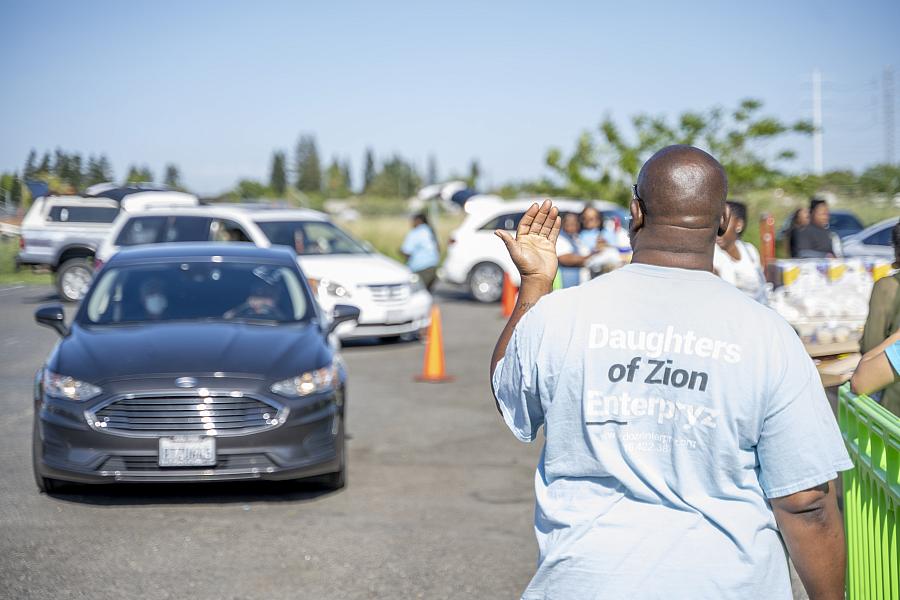
A volunteer with DOZ directs a line of cars during a recent food distribution. The weekly giveaway gets so much traffic, area residents have complained, prompting organizers to ask people not to arrive hours before they begin handing out food boxes.
Russell Stiger Jr., OBSERVER
Watkins would like to see more Black people coming and getting food she knows they need, and not just during holiday giveaways, but says outreach to the nearby complexes doesn't usually garner much participation.
“We get an array of cultures and people, but not as many African American people,” she said.
That’s for various reasons, Watkins adds. While the face of the hungry has changed, there’s still a stigma in the Black community around not having money for food and asking for help. Some folks don’t want to be seen in line or walking home with a food box. Others have told DOZE staffers that they don’t want to take food out of the mouths of “those who need it more.”
There’s also negative perceptions about the quality of food at the giveaways. Some people hear ‘food reclamation’ and automatically think of dumpster diving.
“They think it's expired, it’s old and that's not the case at all,” Watkin says. “These misnomers are problematic because many people that have needs are not being beneficiaries.
“It's not what people think,” Watkins says. “We have fruits, we have vegetables. We do our USDA standard staples, but we give out turkeys, we give out ribs, we give out steak. We exist to help supplement individuals, especially as the price of everything is on the rise and food is expensive.”
Recent boxes at the Neighbor Program’s Oak Park distribution included individual and family-sized salads, steaks and gallons of cold milk.
“We provide good food that sustains families, to help them through this hard time,” Watkins said of local efforts.
Word gets out to other cultures that there’s free food to be had and they come for it. The Neighbor Program will hand a box to anyone who shows up, even the older white veteran who’s shown up begrudgingly, despite an apparent disdain for people of color.
“Why are we the ones that are feeding you?,” McGowan says. “Why is it this unpaid labor of all of these African folks who are waking up early, who are driving and picking up this food, who are organizing all of this to make sure that you can get fed? We need to address the contradiction.”
A box of peanut butter and powdered potatoes won’t likely lead to many kumbaya powwows, but it’s definitely food for thought.
A Sense of Urgency
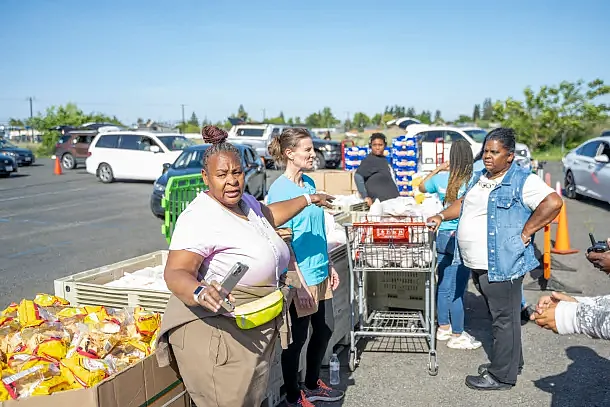
Deborah Watkins facilitates the Daughters of Zion Enterpryz food giveaways with a welcoming smile of a community grandmother and the command of a drill sergeant. “We have plenty,” she tells volunteers.
Russell Stiger Jr., OBSERVER
In the past, food banks were treated as an emergency resource, but today, people are relying on them far more frequently. The California Association of Food Banks (CAFB) has released a new report on the impact of CalFresh emergency allotments (EAs) that bolstered food assistance benefits for families during the pandemic. Those allotments ended in March 2023. The report highlights the role of food banks in meeting increased food needs.
“Food banks have reported serving more people and distributing more food since EAs ended, and most have had to use a disproportionate share of their budget or tap into reserves to provide food to their communities,” reads an excerpt.
Demand has not gone down, says CAFB CEO Stacia Hill Levenfield.
“The economy hasn't recovered in every sector, the prices are just astronomical, and that affects the food banks as well.,” Hill Levenfield said.
Twenty percent of California’s population is food insecure, according to Hill Levenfield. Disproportionate rates in Black and brown communities can be traced to continued inequity, she adds.
“Historically, systemic racism is at the heart of a lot of the intersectionality of poverty in the US,” Hill Levenfield said. “Hunger is a symptom of a lot of that.”
The pandemic offered up valuable lessons in the fight against hunger. During the pandemic, extra CalFresh allotments were added but about a year ago the programs started getting repealed.
The 41 food banks within the CFBA serve six million people a month, according to Hill Levenfield.
“That’s a million more than last year before all of the supports were repealed,” she says.
Hill Levenfield was at the State Capitol this month for a Food ACCESS 2024 Conference, calling for lawmakers and other stakeholders to pay attention to Gov. Gavin Newsom’s budget revisions and potential threats to their anti-hunger efforts.
“We know that when people have access to things like Earned Income Tax Credit, the coworking programs, and CalFresh benefits, they're able to rebalance their lives and with the stability of having that revenue, it’s an economic mobility. It helps to move people out of poverty. But it's the intersectionality and the recognition that there are systems that have been placed over time that have been driving that hunger and causing this to be a cycle of poverty instead of (a temporary situation).”
Knowledge Is Power
Like the Panthers of old, today’s food program organizers point to the direct correlation between food insecurity and community health and well-being. A study by the U.S. Department of Agriculture (USDA) found higher rates of chronic diseases such as hypertension, heart disease, stroke, cancer, asthma, diabetes, chronic obstructive pulmonary disease (COPD), and kidney disease in low income adults. All of these health issues impact the Black community at higher rates.
DOZ is also seeing a rise in seniors in their 70s and 80s, specifically seeking produce. A 2022 study on the link between fruit and vegetable intake among older African Americans and Hispanics and cardiovascular health found that African Americans consumed significantly less fruits and vegetables. Among those with access to fruits and vegetables, 78% did not meet the guidelines.
Experts tout the benefits of a healthy diet in decreasing the risks of chronic illnesses that plague the Black community such as diabetes and high blood pressure. Distributions are often given with “you get what you get” or “beggars can’t be choosers” mindsets, but for many, it’s not simply a matter of being picky. They have real health and dietary concerns, but lack the resources to keep up with them.
“We do all types of stuff to make sure that when our product goes out, it represents that it came from us. Not somewhere ‘we got it from,’ but that it comes from our agency and our ‘agency of care.’
They do their own quality control, she says, in an effort to ensure that people don’t see “discarded food” as a reflection of their own worth.
Not doing so, Watkins says, would be in direct conflict with DOZ’ motto, “Touching the heart of God by touching the heart of the people.”
“God doesn't do people ‘any type of way,” she said. “We stick by that.”
Through other donations from partner organizations, and sometimes from their own hearts and pockets, DOZ provides additional support like diapers for area moms with small children. There’s often pet food for animal owners or kitchenware for formerly incarcerated individuals transitioning back into the community.
“People are coming out of prison. They’re starting over, with nothing to cook the food with,” Watkins said.
Community-based organizers say they’re able to reach people who aren’t served by mainstream food banks.
“Some people won't come to us, but we know they have needs and we'll find them and go to them,” Watkins said.
DOZ volunteers link up with partnering organizations like City of Refuge and First Step Communities and go to homeless encampments with items specifically with the unhoused in mind— from canned goods with pop tops to ready-made food that don’t require refrigeration or cooking. Fully-cooked bacon is handed out and extra loads of apples and tangerines have also been earmarked for unhoused neighbors.
“We definitely think of them and give those things out there so that they have some nutrients while they're eating on that candy bar. Or maybe we can give them a protein bar instead. We’re always trying to think regarding our community and how to best support them,” Watkins said.
Community advocate Lisa Baker, who has personally experienced homelessness, gives out fresh fruits and vegetables in the Meadowview area through her “Feed The Hood” effort.
“There’s a lot going on and people need help,” Baker said.
Along with the food, she also hands out fliers on area resources.
“I give out information that feeds the soul,” Baker said.
Insufficient Funds
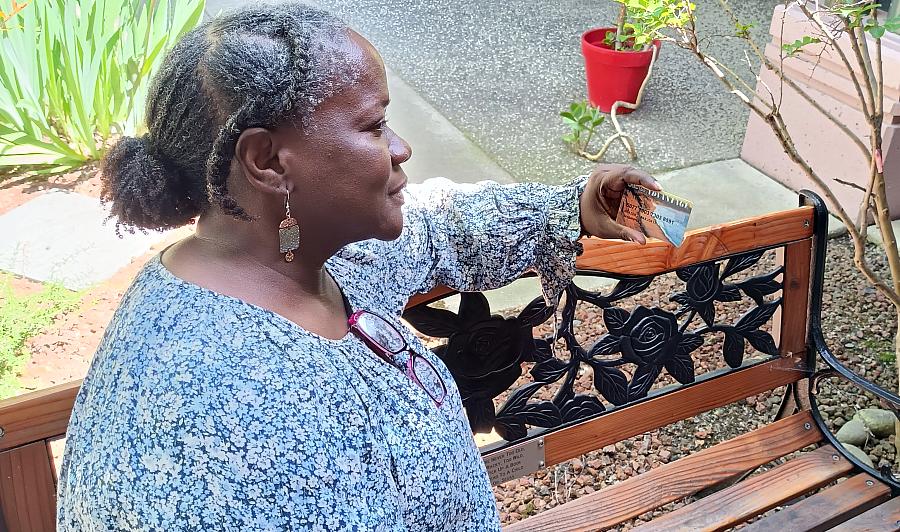
Marjorie Beazer relies on her EBT card to pay for food. The area senior, who is currently homeless, struggles to make her monthly allotment work. She went to an area food bank but was given more than she could store while living outdoors.
Genoa Barrow, OBSERVER
Local senior Marjorie Beazer is currently homeless in the South Sacramento area and facing food insecurity.
“I get $87 a month,” said Beazer, 61.
“I can spend $87 without leaving the (dairy) section,” she adds.
Beazer originally qualified for $27. Upon asking what she was supposed to do with that, her eligibility worker found a way to “bump it up a little bit.” She relies on $1,300 a month in Social Security for other expenses.
“If I'm not strategic, I am hungry,” Beazer says.
Beazer recently graduated from Women’s Empowerment, an eight-week program that helps local women through instability. She has yet to secure employment or housing as other participants have. To supplement things, Beazer tried going to a food distribution in Midtown, but found the experience unfruitful as a homeless person.
“I only went once because you get so much and a lot of it is perishable. How am I going to carry this food? Where exactly am I going to put it?,” she asked. “Because I don't have a refrigerator, or a way to store anything, I have to eat as I go. I can't save it because there's no place to save it.”
Some people trade what they get with others, but Beazer says that wouldn’t work in her case.
“I don’t have any relationships in the homelessness community. I'm new to this ‘space.’”
She adds, “I’m not able to feed myself. There’s a system in place to help me feed myself and even then, because I am housing insecure, you won’t give me as much as you would give somebody who isn’t housing insecure. How exactly does that work? You set me up to fail in so many areas.”
According to the USDA, 9.1 percent of U.S. households with adults aged 65 and older had difficulty getting enough food for all their members at some time during 2022. That was up significantly from 7.1 percent in 2021 and 6.9 percent in 2020. In 2022, 11.4 percent of households with an adult aged 65 and older living alone were food insecure. That too was higher than 2021, when the rate was 9.5 percent and 2020, when it was 8.3 percent.
To stand in the gaps, Sacramento Food Bank & Family Services offers a Food for Seniors program aimed at improving the health of low-income seniors by supplementing their diets with nutritious foods. Those who are aged 60 and older, who meet certain income guidelines, can pick up 30-pound pre-packed boxes at nine distribution sites throughout the county. The Elk Grove Food Bank has “Senior Hour,” time on Friday mornings that its warehouse exclusively opens for older adults. In addition to its on-site food distribution, the Twin Lakes Food Bank delivers groceries to senior centers and older homebound adults in Folsom, El Dorado Hills and Granite Bay.
Rising to the challenge
Like the Neighbor Program, DOZ also utilizes youth volunteers to help assemble and distribute food. Some are being raised by grandparents on limited incomes themselves. Watkins compliments their contributions to the cause and tries to meet needs she sees them have. As a thank you for going above and beyond to help, one young man got a pair of Jordans when some donated sneakers came in. Children are often teased and bullied by others at school when their families can’t afford popular shoe brands.
“It's all about empowerment,” Watkins says.
“Just the other week, a gentleman came in, he’s homeless. As we’re setting up, he says, ‘Can I come in and help?’ I was like, ‘Yeah, man, come on.’ He helped us sort the boxes and the food. After he helped and it was time to serve, he got right back in line.”
Addressing hunger is an all hands on deck type thing, Ali says. One that she considers a responsibility and a privilege.
“It's just what we should be doing,” she said. “It feels good…It feeds you.”
McGowan agrees.
“It’s not charity,” he says. “It’s a revolution.”
EDITOR’S NOTE: This article is part of OBSERVER Senior Staff Writer Genoa Barrow’s four-part series, “Hunger Pains,” focusing on food insecurity in the Black community. The series is being supported by the USC Annenberg Center for Health Journalism and is part of “Healing California,” a yearlong reporting Ethnic Media Collaborative venture with print, online and broadcast outlets across California. The OBSERVER is among the collaborative’s inaugural participants.

